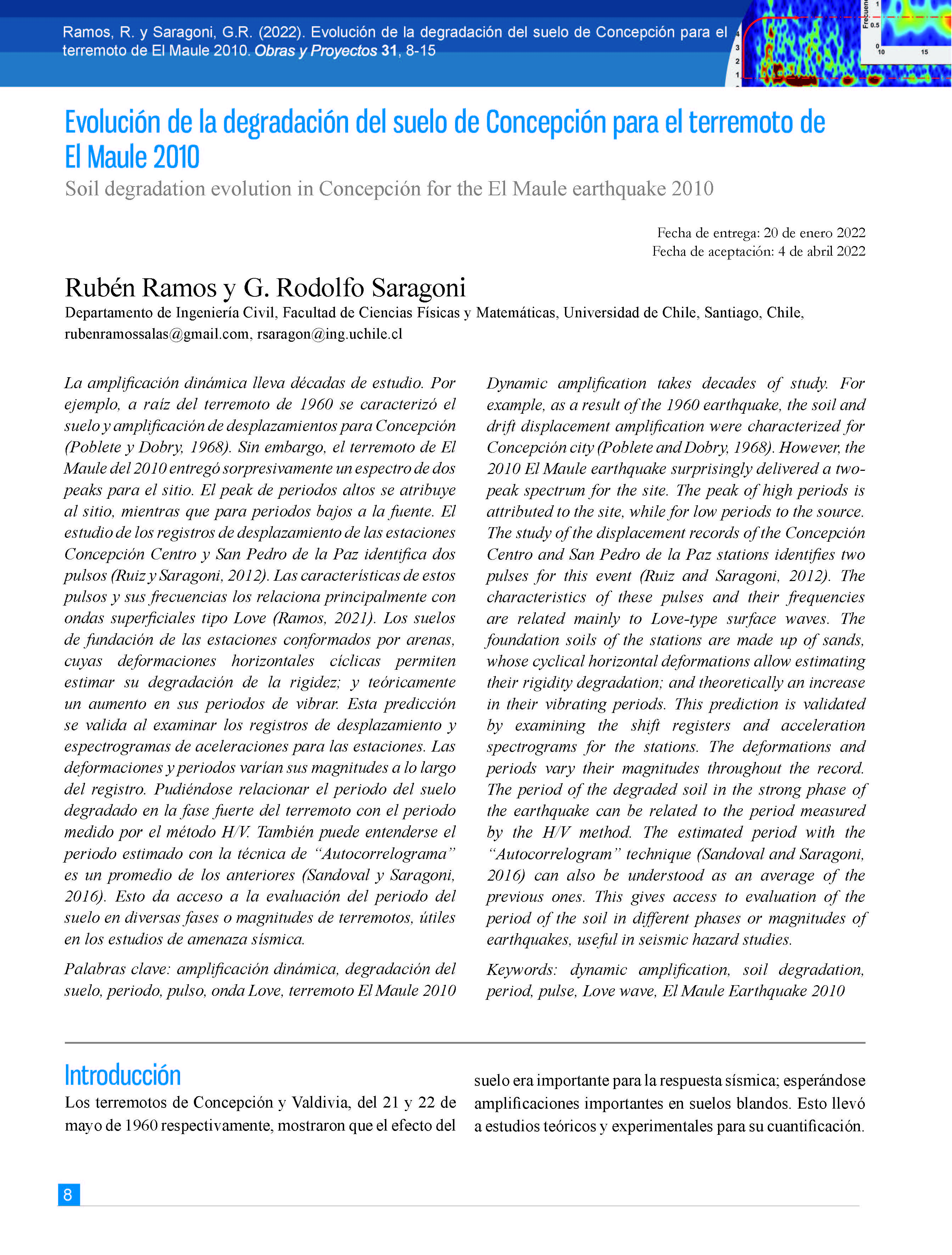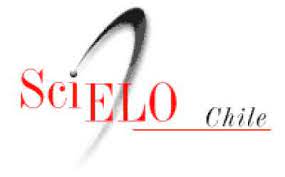Evolución de la degradación del suelo de Concepción para el terremoto de El Maule 2010
DOI:
https://doi.org/10.4067/s0718-28132022000100006Palabras clave:
Amplificación dinámica, Degradación del suelo, Periodo, Pulso, Onda Love, Terremoto El Maule 2010Resumen
La amplificación dinámica lleva décadas de estudio. Por ejemplo, a raíz del terremoto de 1960 se caracterizó el suelo y amplificación de desplazamientos para Concepción (Poblete y Dobry, 1968). Sin embargo, el terremoto de El Maule del 2010 entregó sorpresivamente un espectro de dos peaks para el sitio. El peak de periodos altos se atribuye al sitio, mientras que para periodos bajos a la fuente. El estudio de los registros de desplazamiento de las estaciones Concepción Centro y San Pedro de la Paz identifica dos pulsos (Ruiz y Saragoni, 2012). Las características de estos pulsos y sus frecuencias los relaciona principalmente con ondas superficiales tipo Love (Ramos, 2021). Los suelos de fundación de las estaciones conformados por arenas, cuyas deformaciones horizontales cíclicas permiten estimar su degradación de la rigidez; y teóricamente un aumento en sus periodos de vibrar. Esta predicción se valida al examinar los registros de desplazamiento y espectrogramas de aceleraciones para las estaciones. Las deformaciones y periodos varían sus magnitudes a lo largo del registro. Pudiéndose relacionar el periodo del suelo degradado en la fase fuerte del terremoto con el periodo medido por el método H/V. También puede entenderse el periodo estimado con la técnica de “Autocorrelograma” es un promedio de los anteriores (Sandoval y Saragoni, 2016). Esto da acceso a la evaluación del periodo del suelo en diversas fases o magnitudes de terremotos, útiles en los estudios de amenaza sísmica.
Referencias
Archuleta, R.J., Bonilla, L.F. and Lavallee, D. (2000). Nonlinearity in observed and computed accelerograms. 12th World Conference on Earthquake Engineering, Auckland, New Zealand, paper No. 1934.
Arias, A. y Petit Laurent, L. (1965). Un modelo teórico para los acelerogramas de temblores fuertes. Revista del IDIEM 4(1), 29-60.
Bonilla, L.F., Tsuda, K., Pulido, N., Régnier, J. and Laurendeau, A. (2011). Nonlinear site response evidence of K-NET and KiK-net records from the 2011 off the Pacific coast of Tohoku Earthquake. Earth Planets Space 63, 785-789.
Bonilla, L.F., Guéguen, P. and Gélis, C. (2021). Contribution of K-NET and KIK-NET data to the monitoring of nonlinear properties of the shallow crust. 6th IASPEI/IAEE International Symposium: The Effects of Surface Geology on Seismic Motion. Kyoto, Japan.
Boroschek, R.L., Contreras, V., Kwak, D.Y. and Stewart, J.P. (2012). Strong ground motion attributes of the 2010 Mw 8.8 Maule, Chile, earthquake. Earthquake Spectra 28(1), 19-38.
Boroschek, R., Soto, P. y León, R. (2010). Registros del terremoto del Maule Mw = 8.8, 27 de febrero de 2010. Informe RENADIC 10/05, Departamento de Ingeniería Civil, Facultad de Ciencias Físicas y Matemáticas, Universidad de Chile, Santiago, Chile.
Dobry, R. (1966). Plan de microrregionalizacion sísmica de Concepción. Revista del IDIEM 5(2), 147-149.
IDIEM (2012). Caracterización geotécnica de las estaciones de acelerógrafos de la Universidad de Chile. Santiago, Chile.
Leyton, F. (2019) Comunicación personal.
NCh433 (1972). Diseño sísmico de edificios. INN, Santiago, Chile.
Poblete, M. y Dobry, R. (1968). Modelo dinámico del subsuelo de Concepción. Revista del IDIEM 7(3), 111-136.
Ramos, R. (2021). Efecto de la directividad del terremoto de El Maule 2010 en el daño de la ciudad de Concepción. Tesis de Magister, Universidad de Chile, Santiago, Chile.
Ramos, R. and Saragoni, R. (2020). Directivity evidence for the Concepcion city damage in the El Maule, Chile 2010 earthquake. 17th World Conference of Earthquake Engineering, Sendai, Japan.
Sandoval, M., Saragoni, R. y Ruiz, S. (2016). Periodos y amortiguamientos viscosos del suelo de Concepción estimados de los acelerogramas del terremoto de El Maule, Chile 2010. IX Congreso Chileno de Ingeniería Geotécnica, Valdivia, Chile.
Saragoni, R. y Ruiz, S. (2012). Implicaciones y nuevos desafíos de diseño sísmico de los acelerogramas del terremoto de 2010. En Mw = 8.8 Terremoto en Chile, 27 de febrero 2010. Capítulo 6. Departamento de Ingeniería Civil, Facultad de Ciencias Físicas y Matemáticas, Universidad de Chile, Santiago, Chile, 127-146.

Descargas
Publicado
Número
Sección
Licencia

Esta obra está bajo una licencia internacional Creative Commons Atribución-NoComercial 4.0.







